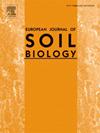Pedogenesis of volcanic ash soils determines the soil microbial pool and its contribution to nutrient availability
IF 3.3
2区 农林科学
Q1 ECOLOGY
引用次数: 0
Abstract
Pedogenesis is a key factor driving nutrient immobilization and mineralization, particularly relevant in the fertility management of volcanic soils. These processes have a strong effect on plant production, but also on the functionality of a soil microbial pool. This research aimed to determine the effect of substrate addition on soil microbial pool, substrate use and nitrogen availability by performing a double labeling study (13C and 15N isotope labeling) in five different volcanic ash soils under permanent pastures. Disturbed soil samples were collected in five volcanic ash soils between the Andes and Coastal Mountains of Chile to evaluate contrasting pedogenesis. Soils were incubated for 16 days at 20 °C and a 60 % water holding capacity. Destructive sampling was carried out on days 1, 2, 3, 6, 9 and 16. Labeling was tracked through the consumption by the microbial biomass, functional genes, stoichiometric imbalances between microbial C/N, enzymatic C/N and the release of CO2 during the incubation period. Ultisol and well-developed Andisol (“Older soils”) with higher organic matter content (∼14 %) showed higher available 15N contents, higher 13C-CO2 respiration, and immobilization of substrate into microbial biomass (i.e., 13C-MBC). This study found that depending on the pedogenesis of the soil, N availability from mineral N and N-acquiring enzyme activities changed as a function of a microbial pool inherent in each soil. Thus, the effect of the initial activity of the soil microbial pool on N availability will allow adjusting fertilization strategies in soils with high levels of organic matter such as volcanic ash soils.

火山灰土的成土作用决定了土壤微生物库及其对养分有效性的贡献
成土作用是驱动养分固定和矿化的关键因素,尤其与火山土壤的肥力管理有关。这些过程对植物生产有很强的影响,但也对土壤微生物库的功能有很大的影响。本研究通过对5种不同永久牧场下的火山灰土壤进行13C和15N同位素双标记研究,以确定添加基质对土壤微生物库、基质利用和氮有效性的影响。在智利安第斯山脉和海岸山脉之间的五个火山灰土壤中收集了扰动土壤样品,以评估对比的土壤形成过程。土壤在20°C和60%保水能力条件下培养16天。在第1、2、3、6、9和16天进行破坏性采样。通过微生物生物量的消耗、功能基因、微生物C/N、酶C/N之间的化学计量失衡以及孵化期间二氧化碳的释放来跟踪标记。有机物质含量较高(~ 14%)的Ultisol和发育良好的andiol(“老土壤”)显示出更高的有效15N含量,更高的13C-CO2呼吸,以及将底物固定为微生物生物量(即13C-MBC)。本研究发现,根据土壤的成土作用,矿质氮和氮获取酶活性的氮有效性随每种土壤中固有的微生物库的功能而变化。因此,土壤微生物库的初始活性对氮有效性的影响将有助于调整有机质含量高的土壤(如火山灰土壤)的施肥策略。
本文章由计算机程序翻译,如有差异,请以英文原文为准。
求助全文
约1分钟内获得全文
求助全文
来源期刊

European Journal of Soil Biology
环境科学-生态学
CiteScore
6.90
自引率
0.00%
发文量
51
审稿时长
27 days
期刊介绍:
The European Journal of Soil Biology covers all aspects of soil biology which deal with microbial and faunal ecology and activity in soils, as well as natural ecosystems or biomes connected to ecological interests: biodiversity, biological conservation, adaptation, impact of global changes on soil biodiversity and ecosystem functioning and effects and fate of pollutants as influenced by soil organisms. Different levels in ecosystem structure are taken into account: individuals, populations, communities and ecosystems themselves. At each level, different disciplinary approaches are welcomed: molecular biology, genetics, ecophysiology, ecology, biogeography and landscape ecology.
 求助内容:
求助内容: 应助结果提醒方式:
应助结果提醒方式:


